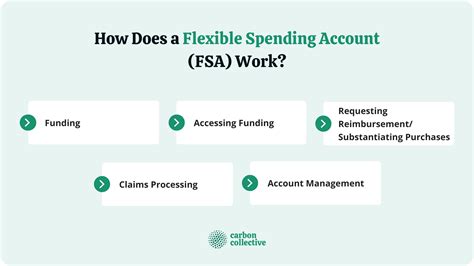Flexible Spending Accounts, commonly referred to as FSAs, are employer-sponsored benefits that allow employees to set aside a portion of their paycheck on a pre-tax basis to pay for eligible healthcare or dependent care expenses. The primary purpose of an FSA is to help individuals save money by reducing their taxable income, thereby lowering their tax liability.
Key Components of an FSA:
- Employee Contributions: Employees elect to contribute a certain amount of money from their paycheck to their FSA on a pre-tax basis. The contribution amount is typically deducted from the employee’s gross income, which reduces their taxable income.
- Employer Administration: The employer is responsible for administering the FSA program, which includes managing employee contributions, processing claims, and providing education and support to employees.
- Eligible Expenses: FSAs are designed to reimburse employees for eligible expenses related to healthcare or dependent care. Common eligible expenses include medical copays, prescription medications, dental care, vision care, and childcare costs.
- Annual Limits: The Internal Revenue Service (IRS) sets annual limits on the amount of money that can be contributed to an FSA. For the 2022 plan year, the annual limit is 2,850 for healthcare FSAs and 5,000 for dependent care FSAs.
How FSAs Work:
- Enrollment: Employees enroll in their employer’s FSA program during the annual open enrollment period or when they first become eligible for benefits.
- Contributions: Employees contribute to their FSA through payroll deductions, which are made on a pre-tax basis.
- Claim Submission: When an employee incurs an eligible expense, they submit a claim to the FSA administrator, along with supporting documentation, such as receipts or invoices.
- Reimbursement: The FSA administrator reviews the claim and reimburses the employee for the eligible expense, up to the available balance in their FSA account.
- Grace Period: Some FSA plans offer a grace period, which allows employees to incur expenses after the plan year has ended and still receive reimbursement from their FSA account.
- Forfeiture: If an employee does not use all of the funds in their FSA account by the end of the plan year (or during the grace period, if applicable), they may forfeit the remaining balance, although some plans may allow employees to carry over a limited amount to the next plan year.
Types of FSAs:
- Healthcare FSA: Reimburses employees for eligible healthcare expenses, such as medical copays, prescription medications, and dental care.
- Dependent Care FSA: Reimburses employees for eligible dependent care expenses, such as childcare costs or elder care expenses.
- Limited Purpose FSA: Reimburses employees for eligible healthcare expenses, but only for certain types of expenses, such as dental or vision care.
Benefits of FSAs:
- Tax Savings: FSAs help employees reduce their taxable income, which can result in significant tax savings.
- Convenience: FSAs provide a convenient way for employees to pay for eligible expenses, as they can use a debit card or submit claims online.
- Budgeting: FSAs help employees budget for expected expenses, such as childcare costs or medical expenses.
Considerations and Potential Drawbacks:
- Use-It-or-Lose-It Rule: If an employee does not use all of the funds in their FSA account by the end of the plan year (or during the grace period, if applicable), they may forfeit the remaining balance.
- Administrative Fees: Employers may charge administrative fees to manage the FSA program, which can reduce the overall value of the benefit.
- Limited Availability: FSAs are typically only available to employees who work for employers that offer the benefit, which can limit access to these plans.
Best Practices for Using an FSA:
- Carefully Review Eligible Expenses: Ensure you understand what expenses are eligible for reimbursement under your FSA plan.
- Track Your Expenses: Keep accurate records of your expenses and submit claims promptly to avoid missing the deadline.
- Plan Ahead: Estimate your expenses for the plan year and contribute accordingly to avoid forfeiting funds.
- Take Advantage of the Grace Period: If your plan offers a grace period, take advantage of it to incur expenses after the plan year has ended.
It's essential to carefully review your FSA plan documents and understand the rules and regulations surrounding your specific plan. By doing so, you can maximize the benefits of your FSA and minimize the risk of forfeiting funds.
What is the annual limit for healthcare FSA contributions?
+The annual limit for healthcare FSA contributions is $2,850 for the 2022 plan year.
Can I use my FSA to reimburse expenses for my dependents?
+Yes, you can use your FSA to reimburse expenses for your dependents, such as childcare costs or medical expenses, if they are eligible under your FSA plan.
What happens to my FSA balance if I leave my job?
+If you leave your job, you may be able to take your FSA balance with you, depending on the terms of your plan. However, you should review your plan documents to understand the specific rules and regulations surrounding your FSA.
By understanding how FSAs work and following best practices for using these accounts, employees can maximize the benefits of their FSA and reduce their out-of-pocket expenses for healthcare and dependent care.


